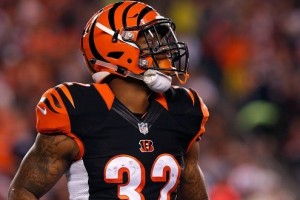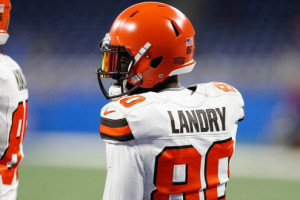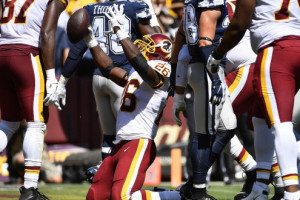Playing the Field: Multi-Site Value Searching Tool
Here is a link to Eddie’s incredible site-by-site pricing comparison tool!
For some insight into the theory behind it and his background, read on. For tips on best using the data, skip to the “Application” section below.
Playing the Field
I’ve been fortunate enough to spend a great deal of my life, both personally and professionally, playing and working on games. I’ve worked on games and licenses for Marvel and DC comics, for WWE, and for Blizzard Entertainment. I owned a game store and tournament center for twelve years. I still play every sport I can as often as I can. Books, dice, board games, consoles, ridiculous costumed role-playing; you name it, I’ve gamed it.
Hell, I even got the license plate.

And it was through that lens, as a gamer, that I approached daily fantasy sports. Some people game to win, for the pride or the prizes. Many of us game for the high. The “gamer high” comes from slowly figuring it out. Knowing that there is a fleeting bit of improvement that you can’t yet see or identify, but you know is out there somewhere, and that nothing stands between you and it, but some work.
Games can be solved. “Solved games” are games in which if all the players know what they are doing, the outcome can be perfectly predicted. Did you know that if you play Connect Four, and play the first checker, and know what you are doing, you cannot lose? No matter what your opponent does, you will win.
I travel regularly to conventions to play all sorts of games, and quite frequently, serious players will decline to play certain games because they have been – at least mostly – solved. The correct sequence of plays and the ideal order of operations have been determined. If he wants to win, the player has a very narrow path to tread. There’s no high at all here, you are just going through the motions.
Great games – and most sports – are unsolvable. Either they have too many moving parts or unpredictable elements, but it plays out differently every time. And DFS is certainly such a game.
With all the focus on proving DFS to be a game of skill, one strong piece of supporting evidence is that there are so many different ways to win. Looking at some of our best DFS players, we have sports gurus who either play the games themselves or know them as well as the coaches. We have data analysts whose methodology would be nearly as useful handling stocks as lineups. We have match-up specialists whose greatest edge is being in the best contests against the most ideal opponents.
It is not just a game of skill, but a game of many skills.
As an employee at Fantasy Feud, with the exception of internal contests against other employees, I can no longer play DFS. But when I played, I feel my greatest edge was taking the greatest advantage of playing on multiple sites.
There are many excellent reasons to diversify your play among many DFS sites. You have access to more promotions and exclusives; you will be in a better position to take advantage of overlay when it is available; you can join all manner of contests, not just those offered by a single provider.
But to me, the greatest advantage (by far) is the ability to buy your shares of a player at the cheapest possible price.
Application
All sites use different algorithms and procedures for determining salaries. And, of course, each site has different price value ranges for players. Even tools that tell you the % cost relative to the top player at the position, or the % of your total salary spent, really aren’t very useful because those figures are drastically skewed by the structure of that particular site, and/or the price of the top player.

Let’s use an example:
You are feeling frisky and decide you want some exposure to Jeremy Hill this weekend. You figure the Bengals saw what the Browns did last week – leaning a bit more on Isaiah Crowell – who had great success running up the middle against the 49ers, at the expense of Duke Johnson’s more “scatback” style. You figure the Cincinnati will follow suit and lean more on Hill than Bernard this week, so you want a piece. Here’s Jeremy Hill’s price site by site:
| Player | Position | Team | DK | Draftpot | FD | Aces | FantasyDraft | FantasyFeud | FantasyHub | Yahoo |
|---|---|---|---|---|---|---|---|---|---|---|
| Jeremy Hill | RB | CIN | 12 | 16 | 21 | 7 | 12 | 18 | 18 | 14 |
Jeremy is the seventh most expensive running back at FantasyAces. He gets cheaper around the industry until you land at FanDuel, where he is the 21st most expensive. If you are playing the field, you want to buy your first shares at FD.
This also provides a good example of other tools possibly leading you astray. Hill costs 67.42% as much as the most expensive running back at FD. He’s actually a lower “% of top” at almost every other site. But that has very little to do with his price and more to do with the fact that the top RB at FanDuel this week is only $8,600, while other weeks it stretches over $9,000.
There’s a lot you can do with this data, but the simplest and most consistently profitable usage for me was managing cash game investment. I would divide my cash game budget equally among all sites. So let’s say I was going to spend $1,200 on cash games this weekend, I would spend as close to $150 in cash games as I could on all eight sites. Then, I would take the players I wanted and purchase them first where they were priced the best. So let’s say I decided I wanted some Eddie Lacy in Week 15:
| Player | Position | Team | DK | Draftpot | FD | Aces | FantasyDraft | FantasyFeud | FantasyHub | Yahoo |
|---|---|---|---|---|---|---|---|---|---|---|
| Eddie Lacy | RB | GB | 11 | 14 | 7 | 7 | 11 | 8 | 17 | 20 |
Well, that Yahoo Price is pretty exciting. He’s going in there first, absolutely. And at $17 there, for at least your cash games; if you play at Yahoo and don’t have Lacy, you are doing it wrong.
How much exposure do I want? I’ve divided my investment in eight, so I can have 1/8th exposure or 2/8ths or 3/8ths, etc. If it’s 1/8th, I’m good at just Yahoo. If I want more, I just buy the next cheapest shares and on up. Unless I really love him and want him in all lineups, I’d be unlikely to pay the premium at FanDuel, FantasyAces, or FantasyFeud.
One last use is that scanning quickly through the data allows you to fairly easily spot pricing “mistakes” and find plays you might not otherwise consider – either in cash games or GPPs. As an example, I likely wouldn’t consider Frank Gore normally. He’s wearing down after a long year, tough matchup vs. the Texans, but he’s priced as RB20 or so on most sites and is all the way down at RB42 on FantasyHub…
General Notes:
Limited Value at Extremes: While this data is useful for most players you will use, it is less effective as a single tool on either extreme with regards to either your most or least expensive players.
For your very top guys, their relative rank to each other is not very important compared to their overall % of pool spent, and versus top guys at other positions. Let’s assume, for a moment, you have two sites with identical scoring and pricing. At one the top running back is Adrian Peterson at $8,500, and the second most expensive is Devonta Freeman at $8,400. At the other site, Devonta is highest at $9,000 and AP is $8,900. You still would want your shares at Site 1, where AP is the most expensive guy
For the bottom guys, the numbers are skewed due to the differing floors on sites, as well as the number of pricing points available. So for example, at Yahoo, the cheapest running back is RB48. At FantasyAces, it’s RB102.
So, for the bulk of your lineup this is a great tool to place your players once you have picked them, or at least point out some guys you should investigate further. But at the very top and bottom, some deeper digging is required.
PPR or Not: Different sites have different scoring rules. Most are rarely relevant enough, so we can ignore them for our purposes. The one exception in NFL is whether or not a site gives half a point or a full point per reception. Of the eight sites I’ve included here, it is split evenly four and four.

For a lot of players, this can be largely ignored. Odell Beckham is going to be roughly as monstrous on every site, PPR or not. But for players whose reception-to-touchdown ratio is particularly high or low, their value is skewed one way or the other. So if you are looking at Jarvis Landry, for example, he is WR12 at both DK and FA. You want him more at DK where you are getting that full PPR bonus.
Site-Specific Notes:
Draftpot: I almost didn’t include Draft Pot data because it’s such a unique fish in the DFS ocean. Draftpot has two modes of play, Fan Mode, which has no salary cap at all, and GM Mode, which gives you a budget of DPPG (DraftPotPointsPerGame) to spend. While it functions similarly to a salary cap contest in execution, the GM Mode numbers involved are far less normalized. Due to the “salaries” being just points-per-game with no modifiers, rookies or players who are suspended or injured can end up as huge values. Due to this, you really need to treat Draftpot entirely differently. For example, you might look at Sammy Watkins:
| Player | Position | Team | DK | Draftpot | FD | Aces | FantasyDraft | FantasyFeud | FantasyHub | Yahoo |
|---|---|---|---|---|---|---|---|---|---|---|
| Sammy Watkins | WR | BUF | 14 | 21 | 11 | 9 | 14 | 9 | 17 | 14 |
He’s WR21 at Draftpot and WR9-WR17 everywhere else, sounds good right? Not near enough value for Draftpot. May I present DeAngelo Williams:
| Player | Position | Team | DK | Draftpot | FD | Aces | FantasyDraft | FantasyFeud | FantasyHub | Yahoo |
|---|---|---|---|---|---|---|---|---|---|---|
| DeAngelo Williams | RB | PIT | 3 | 30 | 6 | 5 | 4 | 6 | 6 | 5 |
The greatest function of this chart with regards to Draftpot is actually to spot the outliers and make sure you get all the super-value into your lineup.
FantasyHub: Fantasy Hub’s pricing is very standard, they actually tend to mirror Draft Kings extremely closely. The one factor you need to be aware of is them not removing injured players. Their top three RB by price this week are Jamaal Charles, Le’Veon Bell, and Arian Foster. This can indicate value that isn’t actually present.

Adrian Peterson is their RB5 by price, but he is really the RB2. So you need to adjust for this, and even tricker, the adjustment isn’t consistent; it is more relevant at positions where injuries are common. The rankings for defenses, for example, don’t need to be adjusted at all. QB and TE can basically be taken at face value as well. But 7 of the top 20 running racks and four of the top 20 wide receivers who have been excised from most other sites, are included on Fantasy Hub.
So, when you are looking at rankings for running backs and wide receivers at Fantasy Hub, keep this in mind. For my own use I would normally do an extra layer of data scrubbing and give “true” rankings for Fantasy Hub, but this can be somewhat subjective (who do I remove exactly), so I’ve presented you here with “raw” data. I did remove most, if not all, of the names of players on IR from the data, but the rankings do still show the actual rank by position on each site.
Data:
I didn’t bother with kickers; only applicable on two of eight sites. Any blanks mean the site doesn’t have that player, or my name condensation sub-routines hadn’t yet been calibrated to catch that guy. So while Odell was quite relevant when I was playing, and the various forms of his name all get caught, Ted Ginn wasn’t quit the commodity he is now, so the “.jr” after his name on some sites is preventing his position being captured correctly.
The Week 15 Spreadsheet is attached here for you to sort through.
I am available for questions here in the comments or by message, or on Twitter @FastEddieFear. Good luck.